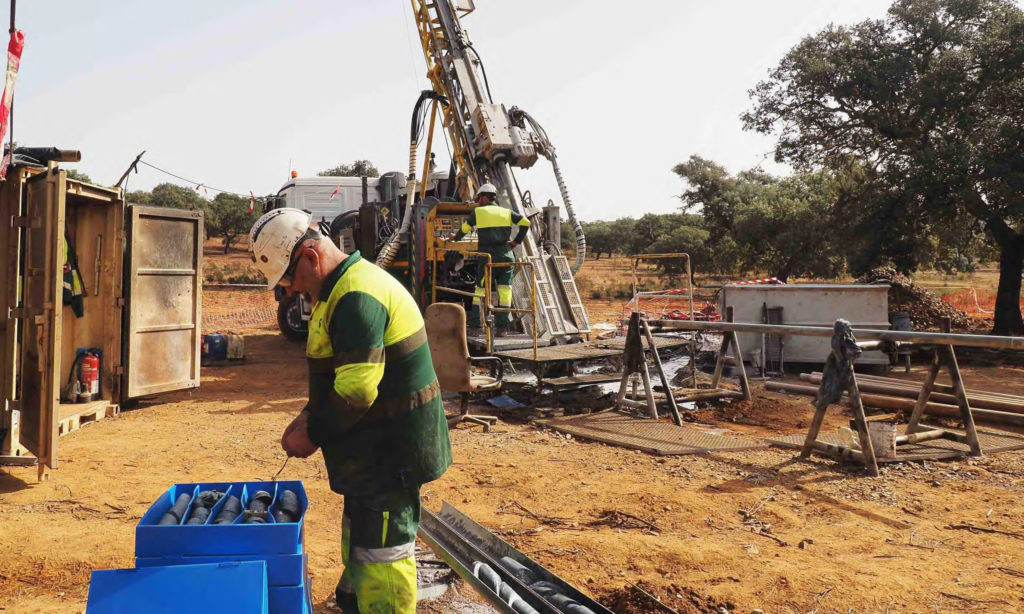Emerita’s first La Romanera resource estimate expected later this month

Iberian Pyrite Belt-focused explorer Emerita Resources (TSXV: EMO; OTCQB: EMOTF) on Monday reported a batch of strongly mineralized intercepts from its La Romanera polymetallic deposit, which will underpin a planned initial resource estimate expected later this month.
The assay results for 21 holes from a recent delineation drilling program at the Roman-era deposit intercepted the two known mineralized lenses. A further pending hole extended the known volcanogenic massive sulphide (VMS) mineralization at depth and towards the east.
The company intersected the deposit’s Upper Lens at 153.1 metres and encountered 6.9 metres grading 0.5% copper, 1.1% lead, 1.9% zinc, 0.97 grams per tonne gold and 28.8 grams per tonne silver. The Lower Lens returned 29.3 metres grading 0.3% copper, 1% lead, 3.4% zinc, 3.83 grams per tonne gold and 39.4 grams per tonne silver from 165.9 metres, including 5 metres grading 0.5% copper, 2.6% lead, 8.3% zinc 6.25 grams per tonne gold and 78.2 grams per tonne silver.
Emerita expects to publish the assay results from another 14 holes before completing the resource estimate by the end of May.
The La Romanera deposit is part of the company’s 100%-owned Iberian Belt West (IBW) project in southern Spain, which comprises the La Infanta, La Romanera and El Cura deposits. All deposits are thought to remain open for expansion along strike and towards depth.
Emerita said a recent downhole transient electromagnetic geophysical survey at La Romanera showed the mineralization continued at depth below the deepest drill hole intersections to date in the lower-central portion of the deposit.
Drill hole LR146 confirmed the extension in this area, returning 34.9 meters of massive sulphide from 580.85 metres, for which assays remain pending. This extends the mineralization 40 meters deeper and almost 100 meters to the east.
Emerita guides that this portion of the deposit will be outside of the initial mineral resource estimate but will serve to increase the deposit size in a future resource estimate.
With the delineation drilling campaign now completed, Emerita’s focus is turning toward resource expansion and regional exploration. The Spain-based Emerita exploration team will focus on several initiatives at IBW, which include more drilling, targeting extensions of La Romanera at depth, strike extensions to La Romanera (including the eastern anomaly) and initial drilling at El Cura prospect.
The Emerita exploration team intends to use downhole geophysics continuously to increase the efficiency of future drill targeting as the drilling continues at depth.
According to the company, an area of higher conductivity has been identified on strike and east of La Romanera. The team intends to drill this anomaly targeting a possible further eastward extension of the known mineralized horizon.
The Iberian Pyrite Belt is widely regarded as one of the most productive volcanogenic massive sulphide terranes globally, with the area playing host to a long history of mining that dates to Roman times.
Minera Rio Tinto previously explored the deposit in the 1990s and has a historical resource comprising 34 million tonnes grading 0.42% copper, 2.2% lead, 2.3% zinc, 44.4 grams silver per tonne and 0.8 gram gold per tonne. The historical estimate contains a higher-grade resource of 11.21 million tonnes grading 0.4% copper, 2.5% lead, 5.5% zinc, 64 grams silver per tonne and 1 gram gold per tonne.
Emerita’s Toronto-quoted share price has been under pressure in recent quarters, falling nearly 60% over the past 12 months to C83¢ per share after touching a high of C$1.98 and a low of C56¢. It has a market capitalization of C$172.1 million ($127m).
{{ commodity.name }}
{{ post.title }}
{{ post.date }}

Comments